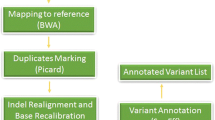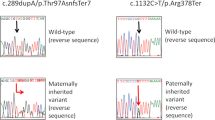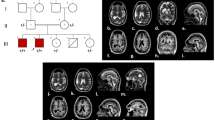Abstract
Primary microcephaly is a disorder characterized by a small head and brain associated with impaired cognitive capabilities. Mutations in 13 different genes encoding centrosomal proteins and cell cycle regulators have been reported to cause the disease. CASC5, a gene encoding a protein important for kinetochore formation and proper chromosome segregation during mitosis, has been suggested to be associated with primary microcephaly-4 (MCPH4). This was based on one mutation only and circumstantial functional evidence. By combining homozygosity mapping and whole-exome sequencing in an MCPH family from Pakistan, we identified a second mutation (NM_170589.4;c.6673-19T>A) in CASC5. This mutation induced skipping of exon 25 of CASC5 resulting in a frameshift and the introduction of a premature stop codon (p.Met2225Ilefs*7). The C-terminally truncated protein lacks 118 amino acids that encompass the region responsible for the interaction with the hMIS12 complex, which is essential for proper chromosome alignment and segregation. Furthermore, we showed a down-regulation of CASC5 mRNA and reduction of the amount of CASC5 protein by quantitative RT-PCR and western blot analysis, respectively. As a further sign of functional deficits, we observed dispersed dots of CASC5 immunoreactive material outside the metaphase plate of dividing patient fibroblasts. Normally, CASC5 is a component of the kinetochore of metaphase chromosomes. A higher mitotic index in patient cells indicated a mitotic arrest in the cells carrying the mutation. We also observed lobulated and fragmented nuclei as well as micronuclei in the patient cells. Moreover, we detected an altered DNA damage response with higher levels of γH2AX and 53BP1 in mutant as compared to control fibroblasts. Our findings substantiate the proposed role of CASC5 for primary microcephaly and suggest that it also might be relevant for genome stability.





Similar content being viewed by others
References
Alderton GK, Galbiati L, Griffith E, Surinya KH, Neitzel H, Jackson AP, Jeggo PA, O’Driscoll M (2006) Regulation of mitotic entry by microcephalin and its overlap with ATR signalling. Nat Cell Biol 8:725–733. doi:10.1038/ncb1431
Anderson L, Henderson C, Adachi Y (2001) Phosphorylation and rapid relocalization of 53BP1 to nuclear foci upon DNA damage. Mol Cell Biol 21:1719–1729. doi:10.1128/MCB.21.5.1719-1729.2001
Awad S, Al-Dosari MS, Al-Yacoub N, Colak D, Salih MA, Alkuraya FS, Poizat C (2013) Mutation in PHC1 implicates chromatin remodeling in primary microcephaly pathogenesis. Hum Mol Genet 22:2200–2213. doi:10.1093/hmg/ddt072
Basmanav FB, Oprisoreanu AM, Pasternack SM, Thiele H, Fritz G, Wenzel J, Grosser L, Wehner M, Wolf S, Fagerberg C, Bygum A, Altmuller J, Rutten A, Parmentier L, El Shabrawi-Caelen L, Hafner C, Nurnberg P, Kruse R, Schoch S, Hanneken S, Betz RC (2014) Mutations in POGLUT1, encoding protein O-glucosyltransferase 1, cause autosomal-dominant Dowling-Degos disease. Am J Hum Genet 94:135–143. doi:10.1016/j.ajhg.2013.12.003
Crasta K, Ganem NJ, Dagher R, Lantermann AB, Ivanova EV, Pan Y, Nezi L, Protopopov A, Chowdhury D, Pellman D (2012) DNA breaks and chromosome pulverization from errors in mitosis. Nature 482:53–58. doi:10.1038/nature10802
Desmet FO, Hamroun D, Lalande M, Collod-Beroud G, Claustres M, Beroud C (2009) Human splicing finder: an online bioinformatics tool to predict splicing signals. Nucleic Acids Res 37:e67. doi:10.1093/nar/gkp215
Fairbrother WG, Yeh RF, Sharp PA, Burge CB (2002) Predictive identification of exonic splicing enhancers in human genes. Science 297:1007–1013. doi:10.1126/science.1073774
Fenech M, Kirsch-Volders M, Natarajan AT, Surralles J, Crott JW, Parry J, Norppa H, Eastmond DA, Tucker JD, Thomas P (2011) Molecular mechanisms of micronucleus, nucleoplasmic bridge and nuclear bud formation in mammalian and human cells. Mutagenesis 26:125–132. doi:10.1093/mutage/geq052
Genin A, Desir J, Lambert N, Biervliet M, Van Der Aa N, Pierquin G, Killian A, Tosi M, Urbina M, Lefort A, Libert F, Pirson I, Abramowicz M (2012) Kinetochore KMN network gene CASC5 mutated in primary microcephaly. Hum Mol Genet 21:5306–5317. doi:10.1093/hmg/dds386
Guernsey DL, Jiang H, Hussin J, Arnold M, Bouyakdan K, Perry S, Babineau-Sturk T, Beis J, Dumas N, Evans SC, Ferguson M, Matsuoka M, Macgillivray C, Nightingale M, Patry L, Rideout AL, Thomas A, Orr A, Hoffmann I, Michaud JL, Awadalla P, Meek DC, Ludman M, Samuels ME (2010) Mutations in centrosomal protein CEP152 in primary microcephaly families linked to MCPH4. Am J Hum Genet 87:40–51. doi:10.1016/j.ajhg.2010.06.003
Hussain MS, Baig SM, Neumann S, Nurnberg G, Farooq M, Ahmad I, Alef T, Hennies HC, Technau M, Altmuller J, Frommolt P, Thiele H, Noegel AA, Nurnberg P (2012) A truncating mutation of CEP135 causes primary microcephaly and disturbed centrosomal function. Am J Hum Genet 90:871–878. doi:10.1016/j.ajhg.2012.03.016
Hussain MS, Baig SM, Neumann S, Peche VS, Szczepanski S, Nurnberg G, Tariq M, Jameel M, Khan TN, Fatima A, Malik NA, Ahmad I, Altmuller J, Frommolt P, Thiele H, Hohne W, Yigit G, Wollnik B, Neubauer BA, Nurnberg P, Noegel AA (2013) CDK6 associates with the centrosome during mitosis and is mutated in a large Pakistani family with primary microcephaly. Hum Mol Genet 22:5199–5214. doi:10.1093/hmg/ddt374
Hussain MS, Battaglia A, Szczepanski S, Kaygusuz E, Toliat MR, Sakakibara S, Altmuller J, Thiele H, Nurnberg G, Moosa S, Yigit G, Beleggia F, Tinschert S, Clayton-Smith J, Vasudevan P, Urquhart JE, Donnai D, Fryer A, Percin F, Brancati F, Dobbie A, Smigiel R, Gillessen-Kaesbach G, Wollnik B, Noegel AA, Newman WG, Nurnberg P (2014) Mutations in CKAP2L, the human homolog of the mouse Radmis gene, cause Filippi syndrome. Am J Hum Genet 95:622–632. doi:10.1016/j.ajhg.2014.10.008
Jackson AP, Eastwood H, Bell SM, Adu J, Toomes C, Carr IM, Roberts E, Hampshire DJ, Crow YJ, Mighell AJ, Karbani G, Jafri H, Rashid Y, Mueller RF, Markham AF, Woods CG (2002) Identification of microcephalin, a protein implicated in determining the size of the human brain. Am J Hum Genet 71:136–142. doi:10.1086/341283
Jamieson CR, Govaerts C, Abramowicz MJ (1999) Primary autosomal recessive microcephaly: homozygosity mapping of MCPH4 to chromosome 15. Am J Hum Genet 65:1465–1469. doi:10.1086/302640
Kaindl AM, Passemard S, Kumar P, Kraemer N, Issa L, Zwirner A, Gerard B, Verloes A, Mani S, Gressens P (2010) Many roads lead to primary autosomal recessive microcephaly. Prog Neurobiol 90:363–383. doi:10.1016/j.pneurobio.2009.11.002
Kalay E, Yigit G, Aslan Y, Brown KE, Pohl E, Bicknell LS, Kayserili H, Li Y, Tuysuz B, Nurnberg G, Kiess W, Koegl M, Baessmann I, Buruk K, Toraman B, Kayipmaz S, Kul S, Ikbal M, Turner DJ, Taylor MS, Aerts J, Scott C, Milstein K, Dollfus H, Wieczorek D, Brunner HG, Hurles M, Jackson AP, Rauch A, Nurnberg P, Karaguzel A, Wollnik B (2011) CEP152 is a genome maintenance protein disrupted in Seckel syndrome. Nat Genet 43:23–26. doi:10.1038/ng.725
Kastan MB, Lim DS (2000) The many substrates and functions of ATM. Nat Rev Mol Cell Biol 1:179–186. doi:10.1038/35043058
Khan MA, Rupp VM, Orpinell M, Hussain MS, Altmuller J, Steinmetz MO, Enzinger C, Thiele H, Hohne W, Nurnberg G, Baig SM, Ansar M, Nurnberg P, Vincent JB, Speicher MR, Gonczy P, Windpassinger C (2014) A missense mutation in the PISA domain of HsSAS-6 causes autosomal recessive primary microcephaly in a large consanguineous Pakistani family. Hum Mol Genet. doi:10.1093/hmg/ddu318
Kilmartin JV, Wright B, Milstein C (1982) Rat monoclonal antitubulin antibodies derived by using a new nonsecreting rat cell line. J Cell Biol 93:576–582
Kiyomitsu T, Obuse C, Yanagida M (2007) Human Blinkin/AF15q14 is required for chromosome alignment and the mitotic checkpoint through direct interaction with Bub1 and BubR1. Dev Cell 13:663–676. doi:10.1016/j.devcel.2007.09.005
Kline SL, Cheeseman IM, Hori T, Fukagawa T, Desai A (2006) The human Mis12 complex is required for kinetochore assembly and proper chromosome segregation. J Cell Biol 173:9–17. doi:10.1083/jcb.200509158
Lancaster MA, Renner M, Martin CA, Wenzel D, Bicknell LS, Hurles ME, Homfray T, Penninger JM, Jackson AP, Knoblich JA (2013) Cerebral organoids model human brain development and microcephaly. Nature 501:373–379. doi:10.1038/nature12517
Liu Q, Guntuku S, Cui XS, Matsuoka S, Cortez D, Tamai K, Luo G, Carattini-Rivera S, DeMayo F, Bradley A, Donehower LA, Elledge SJ (2000) Chk1 is an essential kinase that is regulated by Atr and required for the G(2)/M DNA damage checkpoint. Genes Dev 14:1448–1459
Mahmood S, Ahmad W, Hassan MJ (2011) Autosomal recessive primary microcephaly (MCPH): clinical manifestations, genetic heterogeneity and mutation continuum. Orphanet J Rare Dis 6:39. doi:10.1186/1750-1172-6-39
Marchal JA, Ghani M, Schindler D, Gavvovidis I, Winkler T, Esquitino V, Sternberg N, Busche A, Krawitz P, Hecht J, Robinson P, Mundlos S, Graul-Neumann L, Sperling K, Trimborn M, Neitzel H (2011) Misregulation of mitotic chromosome segregation in a new type of autosomal recessive primary microcephaly. Cell Cycle 10:2967–2977
Marti TM, Hefner E, Feeney L, Natale V, Cleaver JE (2006) H2AX phosphorylation within the G1 phase after UV irradiation depends on nucleotide excision repair and not DNA double-strand breaks. Proc Natl Acad Sci USA 103:9891–9896. doi:10.1073/pnas.0603779103
Petrovic A, Pasqualato S, Dube P, Krenn V, Santaguida S, Cittaro D, Monzani S, Massimiliano L, Keller J, Tarricone A, Maiolica A, Stark H, Musacchio A (2010) The MIS12 complex is a protein interaction hub for outer kinetochore assembly. J Cell Biol 190:835–852. doi:10.1083/jcb.201002070
Petrovic A, Mosalaganti S, Keller J, Mattiuzzo M, Overlack K, Krenn V, De Antoni A, Wohlgemuth S, Cecatiello V, Pasqualato S, Raunser S, Musacchio A (2014) Modular assembly of RWD domains on the Mis12 complex underlies outer kinetochore organization. Mol Cell 53:591–605. doi:10.1016/j.molcel.2014.01.019
Ponting C, Jackson AP (2005) Evolution of primary microcephaly genes and the enlargement of primate brains. Curr Opin Genet Dev 15:241–248. doi:10.1016/j.gde.2005.04.009
Sajid Hussain M, Marriam Bakhtiar S, Farooq M, Anjum I, Janzen E, Reza Toliat M, Eiberg H, Kjaer KW, Tommerup N, Noegel AA, Nurnberg P, Baig SM, Hansen L (2013) Genetic heterogeneity in Pakistani microcephaly families. Clin Genet 83:446–451. doi:10.1111/j.1399-0004.2012.01932.x
Schultz LB, Chehab NH, Malikzay A, Halazonetis TD (2000) p53 binding protein 1 (53BP1) is an early participant in the cellular response to DNA double-strand breaks. J Cell Biol 151:1381–1390
Vassilev LT, Tovar C, Chen S, Knezevic D, Zhao X, Sun H, Heimbrook DC, Chen L (2006) Selective small-molecule inhibitor reveals critical mitotic functions of human CDK1. Proc Natl Acad Sci USA 103:10660–10665. doi:10.1073/pnas.0600447103
Wang H, Hu X, Ding X, Dou Z, Yang Z, Shaw AW, Teng M, Cleveland DW, Goldberg ML, Niu L, Yao X (2004) Human Zwint-1 specifies localization of Zeste White 10 to kinetochores and is essential for mitotic checkpoint signaling. J Biol Chem 279:54590–54598. doi:10.1074/jbc.M407588200
Yeo G, Burge CB (2004) Maximum entropy modeling of short sequence motifs with applications to RNA splicing signals. J Comput Biol 11:377–394. doi:10.1089/1066527041410418
Acknowledgments
We are grateful to all family members for their willingness to participate in this study. We thank Ramona Casper, Nina Dalibor, and Elisabeth Kirst for their expert technical assistance. We are deeply indebted to Prof. Mitsuhiro Yanagida (Department of Gene Mechanisms, Graduate School of Biostudies, Kyoto University, Sakyo-ku, Kyoto, Japan) for the generous gift of anti-CASC5/Blinkin antibodies. This work was supported by intramural grants from Köln Fortune (MSH) and the Center for Molecular Medicine Cologne (PN, AAN).
Author information
Authors and Affiliations
Corresponding authors
Ethics declarations
Conflict of interest
P.N. is a founder, CEO, and shareholder of ATLAS Biolabs GmbH. ATLAS Biolabs GmbH is a service provider for genomic analyses.
Additional information
S. Szczepanski and M. S. Hussain are joint first authors.
Electronic supplementary material
Below is the link to the electronic supplementary material.
Rights and permissions
About this article
Cite this article
Szczepanski, S., Hussain, M.S., Sur, I. et al. A novel homozygous splicing mutation of CASC5 causes primary microcephaly in a large Pakistani family. Hum Genet 135, 157–170 (2016). https://doi.org/10.1007/s00439-015-1619-5
Received:
Accepted:
Published:
Issue Date:
DOI: https://doi.org/10.1007/s00439-015-1619-5




